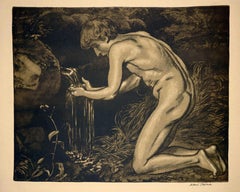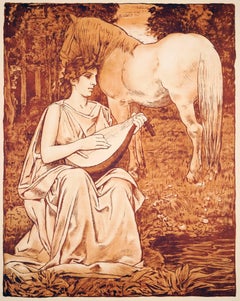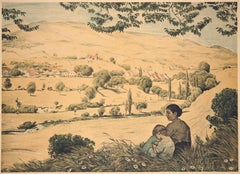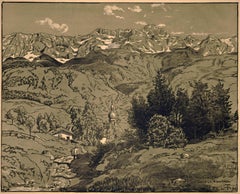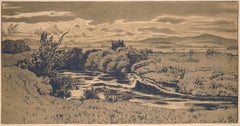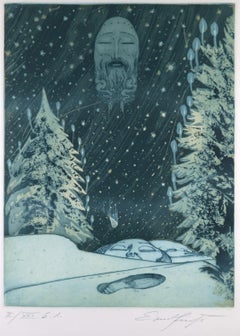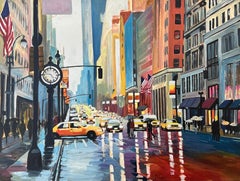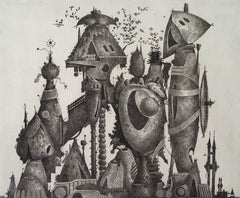Arcadia Art Landscape Prints
to
5
4
7
1
Overall Width
to
Overall Height
to
2
1
1
5
7
1
1
3
8
4
5
4
3
3
3
2
2
2
2
1
1
1
1
1
1
1
1
1
1
1
6
6
4
12
Boy at the source / - Elixir of Life -
Located in Berlin, DE
Hans Thoma (1839 Bernau - 1924 Karlsruhe), Boy at the source, 1897. Algraph on strong wove paper after a drawing from 1897, published by Breitkopf und Härtel in Leipzig as ‘Zeitgenös...
Category
1890s Realist Figurative Prints
Materials
Paper
Muse / - In the realm of the muses -
Located in Berlin, DE
Hans Thoma (1839 Bernau - 1924 Karlsruhe), Muse, 1893. Algraph on strong wove paper, published by Breitkopf und Härtel in Leipzig as ‘Zeitgenössisches Kunstblatt Nr. 174’, 43.5 cm x ...
Category
1890s Realist Figurative Prints
Materials
Paper
Southern German summer landscape / - The profile of the landscape -
Located in Berlin, DE
Hans Thoma (1839 Bernau - 1924 Karlsruhe), Southern German summer landscape, around 1897. Algraph on strong wove paper, published by Breitkopf und Härtel in Leipzig as ‘Zeitgenössisc...
Category
1890s Realist Figurative Prints
Materials
Paper
S. Anton Patenkirchen / - The Home of the Landscape -
Located in Berlin, DE
Hans Thoma (1839 Bernau - 1924 Karlsruhe), S. Anton Patenkirchen, 1895. Algraph on strong wove paper, published by Breitkopf und Härtel in Leipzig as ‘Zeitgenössisches Kunstblatt Nr....
Category
1890s Realist Figurative Prints
Materials
Paper
At the pond / - The longing of the landscape -
Located in Berlin, DE
Hans Thoma (1839 Bernau - 1924 Karlsruhe), At the pond, 1897. Algraph on strong wove paper, published by Breitkopf und Härtel in Leipzig as ‘Zeitgenössisches Kunstblatt Nr. 148’, 23....
Category
1890s Realist Figurative Prints
Materials
Paper
The Lost Trace / - The Holy Night as a real dream -
By Ernst Fuchs
Located in Berlin, DE
Ernst Fuchs (1930 Vienna - 2015 ibid), The Lost Trace, 1972. Vernis mou and aquatint etching, 46.8 x 36.4 cm (plate), 66 x 50 cm (sheet), 69.5 x 53.5 cm (frame), WVZ Hartmann no. 185...
Category
1970s Surrealist Figurative Prints
Materials
Etching
View of a coastal town / - The Pilgrim's View -
Located in Berlin, DE
Albert Ernst (1909 Fronhofen - 1996 Hamburg), View of a Coastal Town, etching, 30 x 37 cm (picture), 45 x 50.5 cm (frame), signed in pencil lower right "Albert Ernst", framed under g...
Category
Mid-20th Century Realist Landscape Prints
Materials
Etching
$237 Sale Price
20% Off
Indistinct Clear - Fluctuating ambivalence -
Located in Berlin, DE
Karl Ludwig Mordstein (1937 Füssen - 2006 Wilszhofen), Undeutlicher deutlich, 1982. Color etching, e.a. (Epreuve d'artiste) 4/9, 22.5 x 28 cm (image), 40 x 45 cm (sheet), 43 x 48 cm ...
Category
1980s Abstract Abstract Prints
Materials
Etching
$455 Sale Price
20% Off
Aus dem Totenbuch einer Stadt (IV) - The presence of the submerged -
Located in Berlin, DE
Karl Ludwig Mordstein (1937 Füssen - 2006 Wilszhofen), From the Book of the Dead of a City (IV), 1983. Color etching, copy 16/60, 15.5 x 18.5 cm (imag...
Category
1980s Abstract Abstract Prints
Materials
Etching
$370 Sale Price
20% Off
Agony - The architecture of decay -
Located in Berlin, DE
Jörg Olberg (*1956 Dresden), Agony, 1987. etching, E.A. (edition of 30), 24 x 17 cm (image), 46 x 37 cm (sheet), each signed in pencil lower right "Olberg" and dated "IX [19]87", inscribed lower left "E.A. [Epreuve d'Artiste]".
- minimal crease and dust stains in the broad margin
- The architecture of decay -
About the artwork
Jörg Olberg draws here the sum of his artistic study of the Berlin ruins, which were still present in the cityscape well into the 80s. With his work "Agony" he creates an allegory of decay. Positioned in the landscape of ruins, a ruined house grows before the viewer, rising like the Tower of Babel into the sky, its roof and gable brightly illuminated by the sun. But already the roof shows mostly only the rafters, and as the gaze is drawn further down, the building visibly disintegrates, the beams protruding in all directions looking like splintered bones. Slowly but inexorably - in agony - the house will collapse in on itself and become nothing more than the burial mound of itself. At the same time, the small-scale stone composition and the plaster form a pattern-like ornamentation of decay.
The tension in the picture is fed by the counter-movement of growth and collapse, which is heightened by the dramatic formation of clouds. The swirls of clouds are reminiscent of a world landscape...
Category
1980s Realist Figurative Prints
Materials
Etching, Paper
$265 Sale Price
20% Off
Three Herons - At the flaming lake -
Located in Berlin, DE
Rudolf Hayder (active in the 1st half of the 20th century), Heron. Color woodcut on thin Japanese paper, 24 x 29 cm (image), 29 x 36 cm (sheet size), signed by hand at lower right "R. Hayder" and titled by hand as "Reiher". Lower left inscribed by hand "Orig.[inal] woodcut, hand print".
- A little bit stained in the margins and very occasionally in the image, minimal hole above the signature, traces of creasing. At the back side's margins with remnants of an old mounting.
About the artwork
In the context of French Japonism, the color woodblock print, which was widespread in the Asian region, was rediscovered for Western art. The artists of the time, such as Édouard Manet, Claude Monet, Edgar Degas, Paul Gauguin and Vincent van Gogh, were inspired not only by the cultural influence, but also by the two-dimensionality of the pictorial spaces. Thus, color woodcuts became an important moment in the development of the modern pictorial concept founded by Impressionism.
In Rudolf Hayder's "Herons", too, the two-dimensionality of the pictorial space is decisive for the pictorial effect. The herons, surrounded by reeds, are framed by the yellow background of the lake, followed by the dark blue-greenish stripe of the opposite shore and, above it, the sky in a lighter blue-green. Formally, it is a sequence of planes, but the two-dimensionality of the motif creates a spatial effect. This spatiality in the surface creates an intense pictorial effect. Hayder intensifies this effect with the blazing lake. In terms of color, the water becomes a sunset. The yellow turns reddish brown toward the shore, then fades to brownish red, while the shore is a watery turquoise...
Category
Early 20th Century Realist Animal Prints
Materials
Color
Evening - The depth of the visible -
Located in Berlin, DE
Max Clarenbach (1880 Neuss - Cologne 1952), Evening. Etching, 18 x 41 cm (platemark), 33.5 x 57 cm (frame), inscribed "Abend" in pencil at lower left, signed and dated "M. Clarenbach. 28.III.[19]09". Framed and mounted under glass.
- Somewhat browned and slightly foxed.
About the artwork
The horizontally elongated etching depicts the panoramic view of a small town as seen from the other side of the river. There are gabled houses on the left and a mighty church spire on the right. The bourgeois houses and the large religious building indicate the urban character. These buildings are rendered in dark tones to emphasise the lighter row of houses in the centre of the picture, closer to the water. The chiaroscuro contrast creates two parallel planes that open up a space for the imagination of what the city could be. The imagination is stimulated by the almost entirely dark, barely recognisable buildings, while the arm of the river leading into the city further stimulates the imagination.
However, as the silhouette of the city as a whole is reflected in the water, the parallel planes are perceived as a band of houses that stretches across the entire horizontality of the etching and seems to continue beyond the borders of the picture. The reflection has almost the same intensity as the houses themselves, so that the band of buildings merges with their reflection to form the dominant formal unit of the picture. Only the parallel horizontal hatching creates the convincing impression of seeing water, demonstrating Max Clarenbach's mastery of the etching needle.
The water is completely motionless, the reflection unclouded by the slightest movement of the waves, creating a symmetry within the formal unity of the cityscape and its reflection that goes beyond the motif of a mere cityscape. A pictorial order is established that integrates everything in the picture and has a metaphysical character as a structure of order that transcends the individual things. This pictorial order is not only relevant in the pictorial world, but the picture itself reveals the order of the reality it depicts. Revealing the metaphysical order of reality in the structures of its visibility is what drives Clarenbach as an artist and motivates him to return to the same circle of motifs.
The symmetry described is at the same time inherent an asymmetry that is a reflection on art: While the real cityscape is cut off at the top of the picture, two chimneys and above all the church tower are not visible, the reflection illustrates reality in its entirety. The reflection occupies a much larger space in the picture than reality itself. Since antiquity, art has been understood primarily as a reflection of reality, but here Clarenbach makes it clear that art is not a mere appearance, which can at best be a reflection of reality, but that art has the potential to reveal reality itself.
The revealed structure of order is by no means purely formalistic; it appears at the same time as the mood of the landscape. The picture is filled with an almost sacred silence. Nothing in the picture evokes a sound, and there is complete stillness. There are no people in Clarenbach's landscape paintings to bring action into the picture. Not even we ourselves are assigned a viewing position in the picture, so that we do not become thematic subjects of action. Clarenbach also refrains from depicting technical achievements. The absence of man and technology creates an atmosphere of timelessness. Even if the specific date proves that Clarenbach is depicting something that happened before his eyes, without the date we would not be able to say which decade, or even which century, we are in. The motionless stillness, then, does not result in time being frozen in the picture, but rather in a timeless eternity that is nevertheless, as the title "Abend" (evening), added by Clarenbach himself, makes clear, a phenomenon of transition. The landscape of the stalls is about to be completely plunged into darkness, the buildings behind it only faintly discernible. The slightly darkened state of the sheet is in keeping with this transitional quality, which also lends the scene a sepia quality that underlines its timelessness. And yet the depiction is tied to a very specific time. Clarenbach dates the picture to the evening of 28 March 1909, which does not refer to the making of the etching, but to the capture of the landscape's essence in the landscape itself.
If the real landscape is thus in a state of transition, and therefore something ephemeral, art reveals its true nature in that reality, subject to the flow of phenomena, is transferred to an eternal moment, subject to a supra-temporal structure of order - revealed by art. Despite this supratemporality, the picture also shows the harbingers of night as the coming darkening of the world, which gives the picture a deeply melancholy quality, enhanced by the browning of the leaf.
It is the philosophical content and the lyrical-melancholic effect of the graphic that give it its enchanting power. Once we are immersed in the image, it literally takes a jerk to disengage from it.
This etching, so characteristic of Max Clarenbach's art, is - not least because of its dimensions - a major work in his graphic oeuvre.
About the artist
Born into poverty and orphaned at an early age, the artistically gifted young Max Clarenbach was discovered by Andreas Achenbach and admitted to the Düsseldorf Art Academy at the age of 13.
"Completely penniless, I worked for an uncle in a cardboard factory in the evenings to pay for my studies.”
- Max Clarenbach
At the academy he studied under Arthur Kampf, among others, and in 1897 was accepted into Eugen Dücker...
Category
Early 1900s Realist Landscape Prints
Materials
Etching
$551 Sale Price
20% Off
Related Items
High Quality Print of New York Rain III Painting by leading British Urban Artist
By Angela Wakefield
Located in Preston, GB
High Quality Print of New York Rain III Painting by leading British Urban Artist, Angela Wakefield. Part of her New York Series. Hand signed by the ...
Category
2010s Realist Landscape Prints
Materials
Paper, Board, Color, Digital
$283 Sale Price
30% Off
H 12 in W 16 in D 1 in
We're All Here
By Valton Tyler
Located in Dallas, TX
In The New York Times Arts in America column, Edward M. Gomez writes of Valton Tyler, "visionary seems the right word for describing his vivid, unusual and technically refined painti...
Category
1970s Surrealist Figurative Prints
Materials
Rag Paper, Etching
"Acupuntura Neoecléctica" contemporary figurative patterns human figure print
By Pedro Friedeberg
Located in Ciudad de México, MX
The repetition of patterns and rhythm is present in almost every piece of Pedro´s work.
The hybrid topographies that Pedro Friedeberg´s unclassifiable practice recreates we must rec...
Category
2010s Surrealist Figurative Prints
Materials
Ink, Paper, Digital
$1,900
H 27.56 in W 22.05 in
Painting of New York Storm Rain on 42nd Street by Leading British Urban Artist
By Angela Wakefield
Located in Preston, GB
A high quality hand-signed limited edition print entitled 'New York Storm' on 42nd Street with the Chrysler Building by Leading British Urban Landscape Artist, Angela Wakefield. Part of her New York Series.
The character of New York’s skyline and large residential districts is often defined by the skyscrapers, street scenes and elegant brownstone row houses, town houses, and shabby tenements that were built during a period of rapid expansion at the end of the 19th century. Angela has now produced over 100 paintings of New York City in her New York Series. “New York City’s five boroughs are home to some of the world’s most recognisable, cherished landmarks and attractions. Angela’s painting style perfectly encapsulates the mood of New York.”
Angela Wakefield (Born 1978) has twice been on the front cover of ‘Art of England’ and featured in ARTnews – the most widely read art magazine in the world. Angela has attracted international attention with her urban landscape paintings of New York, London & the North of England.
The style of painting has been described as ‘contemporary realism’, and she is often favourably compared with Edward Hopper by collectors and art critics. Her work is held in private collections in Europe and the USA, and has been exhibited in London and across the United Kingdom. Angela's admirers include leading figures in international business, filmmaking and the media.
Angela studied at UCLan in the UK, gaining a BA(Hons) in Fine Art. Working with acrylic paint on canvas or board, she is mainly associated with cityscapes and city street scenes, incorporating figurative elements of the landscape, architecture, transportation and the human figure.
Angela Wakefield has undertaken several high-profile commissions:
She was commissioned by the University of York to paint the high profile £800,000 renovation project 'Greg's Place', kindly funded by Greg Dyke, the former Chancellor of the University, FA Boss & Director General of the BBC.
Angela was also commissioned by Stonyhurst College to paint the world-famous Grade 1 listed building. (Former Alumni inching JRR Tolkien...
Category
2010s Realist Landscape Prints
Materials
Color, Giclée, Archival Paper, Paper, Digital
Angela WakefieldPainting of New York Storm Rain on 42nd Street by Leading British Urban Artist, 2024
$283
H 15 in W 11 in D 0.2 in
Salvador Dali - Mission Dolores - San Francisco - Original Hand-Signed Etching
By Salvador Dalí
Located in Collonge Bellerive, Geneve, CH
Salvador Dali - Mission Dolores - San Francisco - Original Hand-Signed Etching
Title: Mission Dolores - San Francisco
Drypoint
Handsigned
Dimensions: 65 x 50 cm
Edition EA
Catalogue ...
Category
1970s Surrealist Figurative Prints
Materials
Etching
$6,882
H 25.6 in W 19.69 in D 0.4 in
Woolworth Building, New York
By Paul Schumann
Located in Middletown, NY
A rich and tonal image of an icon of Manhattan architecture.
Etching with drypoint, 11 7/8 x 7 3/8 inches (300 x 186 mm), full margins. Edition of 100. Signed in pencil, lower right...
Category
Early 20th Century Realist Landscape Prints
Materials
Handmade Paper, Drypoint, Etching
ABOVE THE CLOUDS
Located in Aventura, FL
Lithograph on paper. Hand signed, titled and numbered by the artist. Edition of 350.
Artwork is in excellent condition. Certificate of Authenticity is included. All reasonable o...
Category
1990s Realist Figurative Prints
Materials
Paper, Lithograph
Limited Edition Print of Trafalgar Square, Big Ben in Westminster City of London
By Angela Wakefield
Located in Preston, GB
Limited Edition Print of Westminster from Trafalgar Square with Big Ben, London, by leading British urban landscape artist, Angela Wakefield.
Print measures 12.5 x 10.5 inches
Pape...
Category
2010s Realist Landscape Prints
Materials
Paper, Color, Digital, Giclée
$380 Sale Price
30% Off
H 10.5 in W 12.5 in D 0.5 in
Pastorale, Surrealist Etching and Aquatint by Salvador Dali
By Salvador Dalí
Located in Long Island City, NY
Salvador Dali, Spanish (1904 - 1989) - Pastorale, Portfolio: Historia de Don Quichote de la Mancha, Year: 1981, Medium: Etching and Aquatint on Arches, signed and numbered in penc...
Category
1980s Surrealist Figurative Prints
Materials
Aquatint, Etching
$4,500
H 38 in W 33.5 in
Cambridge Midsummer Fair
By Sir Muirhead Bone
Located in Middletown, NY
A peaceful image by Britian's first official war artist.
Drypoint printed in brownish black ink on fibrous, laid Japon paper, 3 3/8 x 6 5/16 inches (85 x 161 mm), full margins. Sign...
Category
Early 20th Century Realist Landscape Prints
Materials
Handmade Paper, Drypoint
Ancient View of Lago Maggiore - Lithograph on Paper - Mid-19th Century
Located in Roma, IT
Ancient View of Lago Maggiore is an original modern artwork realized in Italy in the first half of the 19th Century.
Original Lithograph on Ivory Paper...
Category
1850s Surrealist Figurative Prints
Materials
Lithograph
$261
H 3.75 in W 5.71 in D 0.04 in
Landscape - Woodcut Print on Paper by Mino Maccari - Early 20th Century
By Mino Maccari
Located in Roma, IT
Landscape is an original modern artwork realized by the Italian artist Mino Maccari (Siena, 1898 - Rome, 1989).
Original woodcut on Ivory paper.
Excellent conditions. Cat. Electa....
Category
Early 20th Century Surrealist Figurative Prints
Materials
Woodcut
$332
H 7.09 in W 8.86 in D 0.04 in
